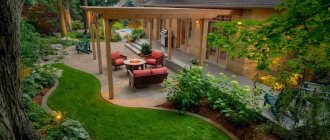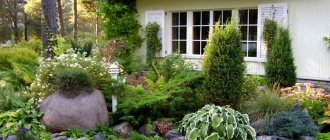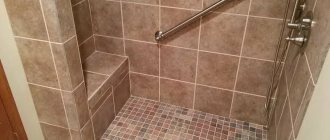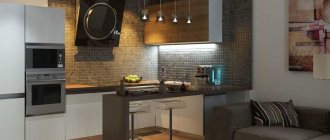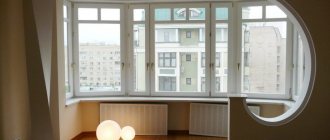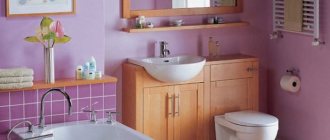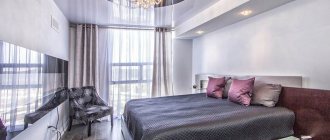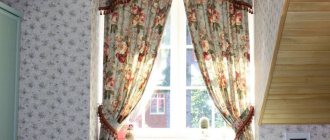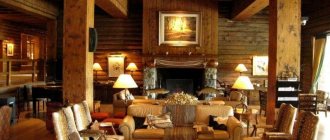A narrow and long area cannot be considered problematic.
Whatever the configuration of the land plot, the design will not be simple. Everything needs to be taken into account: the terrain, the occurrence of groundwater, the wind rose, orientation relative to the cardinal points, soil composition, proximity of urban objects, and many other factors. It is not always possible to choose a plot of the desired shape - we may inherit it, or it is very important for us to build a house in a specific area, and we think about its shape last. When purchasing a summer cottage, we often pay attention to its price and convenient location. Only after a while, when we start planning, do we think about whether a long plot is suitable for us.
Advantages and disadvantages of a narrow section
Many people believe that there are no advantages to an oblong plot of land. However, it is not. Here it makes sense to implement interesting ideas in its zoning. A rectangular plot of land can be easily divided into functional zones, and a suitable use can be found for each. Vineyard lovers will like this form of plot because the narrow space looks advantageous in the design of vines. Even if the territory is inconvenient, it is still possible to allocate a corner for a vegetable garden or garden , and this can be done without compromising the design of the elongated summer cottage.
The inconvenience in a territory of such geometry will be the impossibility of building a house with the layout you like; here you will have to proceed from the options available for such shapes. It will also be problematic to erect a high fence around the plot of land. A blind, high hedge will block sunlight, which is unfavorable for most plants used in landscaping. Trees that are too tall and provide a lot of shade are also not recommended for planting , as they visually conceal the space.
Did you know? Joseph Addison first mentioned the art of landscape design in 1712, but the term still arose much later, in 1828.
An almost impossible task in planning such areas is the problem of sound insulation, especially when there are noise sources in the immediate vicinity. It is advisable to involve specialist designers in planning an elongated garden plot. But if funds are limited, then you can try to arrange your own plot of land, using professional recommendations and special literature.
Minuses
If we talk about disadvantages, such plots, of course, have them, among them:
- Inability to build your dream home. The narrow dimensions of the plot do not always allow you to build exactly the house you wanted.
- Lack of tall trees. In narrow areas, regardless of their length, you will have to abandon large trees, since their crown will shade the area and visually make it even smaller.
- Inability to isolate yourself from neighbors and the road. It is not recommended to install a blind fence around the perimeter of a narrow area.
- Additional expenses for arrangement. Narrow areas are considered difficult to work with. Without skills or special education, it is unlikely that you will be able to improve the territory. Therefore, you will have to hire professional landscape designers.
Planning Features
Long narrow plots are the most difficult to design. Since the area is quite limited and has an original shape, not all available house and garden design projects can be used. However, you should not despair, because there are a number of techniques for visually adjusting the territory. They make it possible to optically expand the space and make its appearance more proportional.
Such tricks include:
- use of diagonals;
- dividing space into different-sized sectors;
- formation of zones.
A site up to 20 m wide is considered narrow. A special feature of its design will be the use of the entire territory, including remote corners. Before planning begins, it is necessary to determine the main purposes of each land plot. For all buildings, you should think about the location in advance.
Learn how to design a rectangular area.
Houses on such areas are built in such a way that the residents living in them feel comfortable and comfortable. There may be a longitudinal or transverse arrangement. All communications should be designed in advance: water supply, sewerage, heating, electrical wiring, gas pipes. This must be done based on the location of the future house, as well as all other buildings on the site.
Location of the house
Since a residential building is the most important detail of any landscape, before designing and building it, you should consider the location of the home so that the side walls face west and east. Only in this case there will be no lack of sunlight in the room. The building shape is often preferred to be rectangular, but other options can be considered when designing.
This largely depends on the characteristics of the terrain. On a plot of this type, it is often possible to fit a building entirely along the wall, however, if you absolutely do not want to do this, you can consider the option of several floors or a house with an attic superstructure. If a rectangular house is chosen as the final one, then you can diversify its design with an original solution.
For example, it could be a building, the exit from the rooms of which can be made directly onto the territory of the garden plot. You can also think about a carriage-type structure, in which the rooms are located one after another and are walk-through . In any case, the minimum width of the room should be 5–6 m, since if the room is narrower, it will be absolutely uncomfortable to be in it.
What zones should be on the territory?
When planning the zoning of non-standard household plots, you need to know the basic rule - the division of the territory should be carried out crosswise . As for the number of zones, their number can reach 6 separate spaces, depending on the length of the territory.
Representative
Another name for it is the front zone. It is located near the front entrance to a residential building. In this zone you can place :
- alpine slides;
- break up flower beds.
When using a lawn, it is recommended to choose asymmetrical varieties. In the same space, you can allocate space for a car, but it should be located to the side, and in no case in the middle of the zone.
Buffer
It is located immediately at the entrance to the territory. Arranging this area is not necessary , but if the size of the plot allows and the owner has a car, it is better to organize it.
You can separate the buffer space from the front space with the help of tall, dense bushes and plant thujas. Another option is to lay out a decorative brick wall, but you need to understand that it can obscure the space.
Private
This is the so-called recreation area, a place where you can retire from noise . To separate it, you can use trellises, pergolas, or you can build a curtain. The space of the private zone can be ennobled with vines and climbing plants. In the center of the zone you can put a gazebo, arrange a green office, or simply hang a hammock.
Specialized
This area is intended for domestic needs. There you can place change houses and a place for drying clothes. If you wish, you can arrange everything beautifully, or you can simply stretch clotheslines, hiding them from prying eyes with curtains and tall bushes.
Unobstructed access must be organized to the specialized area.
Additional
An additional zone can be arranged on long sections.
It may include:
- playground;
- playground;
- garden.
When setting up a playground, it is not recommended to close it off from the front door and the recreation area, since adults must supervise children playing in the additional area.
Some lovers of country life set up a small vegetable garden on their plots in the additional zone. This area should be located near a specialized area.
Choosing a style for an elongated area
To design an elongated plot of land, landscape designers recommend choosing one of the following styles.
- Classic or regular. A feature of this style is the choice of strict geometric shapes. They should be visible in everything: zoning, the shape of garden paths, the appearance of plants. Elements of pristine nature would not be appropriate here: boulders, untrimmed bushes and trees. Treated stones or wood can be used, but everything must be in the correct shape.
- Country. This direction involves stylizing the territory as a village. The style is not too expensive either financially, or in work during design, or in subsequent care. There are no clear and strict lines and shapes expected here, and there are no strict decor rules either. The main principle will be to create rustic comfort. Wood and stone are not processed and retain their natural structure. If there is supposed to be a reservoir, then it would be desirable for it to be overgrown with reeds.
- Japanese. Designed to reveal the beauty of the landscape. The following can be located on a site made in this style: a pond, a terrace, a Japanese gazebo, and large stones. An oriental style garden is characterized by a restrained color palette. It is undesirable to repeat the sizes and shapes of various decorative elements. Everything in this garden should contribute to peace.
- Architectural. It combines components from two design styles: classic and hi-tech. The main elements here are decorative elements in the garden, such as step-by-step paths, terraces, bridges, various arches, borders, and ponds. This garden is easy to maintain.
- Landscape or English. This style is the complete opposite of architectural. The main task here is to emphasize the naturalness and pristine beauty of nature. English gardens are not designed to subjugate the forces of nature, but, on the contrary, to blend harmoniously into the riot of greenery. Smooth lines and a natural look predominate, which promotes relaxation.
Design of a large front garden
If the plot of land is large enough, then you can freely place several interesting plant compositions on it, and, if possible, supplement them with beautiful paths, benches, gazebos and barbecue areas. A beautiful front garden can transform the building itself and the entire space in front of the house.
The easiest way is to place a border flower bed on the site along the wall of the building, install boxes under the windows and hang pots with flowers.
Design options for a large front garden:
Framing the path with bushes.
This technique will make the area neat and attractive if the hedges and bushes are carefully trimmed. It is undesirable to use coniferous plants; they should not be cut. Shrubs and small trees with a lush crown can be decorated in the form of gates and animal figures. Create a frame for the garden path leading to the exit.
Landscape design for a homeSource www.pinterest.ca
Plants that look beautiful all year round.
Such a front garden can be equipped without the help of a specialist. It will decorate the yard all the time, and not just in the summer. To do this, it is enough to place coniferous, bright deciduous and beautifully flowering plants on the site.
Ornamental shrubsSource www.widoczki.com
Succulents on rocks.
Various cacti and succulents, spectacularly arranged on boulders, will add style and color to the area. Some of them tolerate light frosts well and can winter outside.
Rutaria with succulentsSource www.pinterest.ru
Hanging flowerpots and wooden containers.
Decorative pots and cache-pots, made in a modern direction, barrels and even a tree stump (if the house is in a rustic style) will add color and complement the design of the site. Nearby you can build a simple, uncomplicated fountain, a small artificial pond.
Popular articles Pond pump features
Wooden planters for the gardenSource yandex.ru
Fountains, ponds, artificial reservoirs.
These decorative elements can become the main accent of the area in front of the house, its central detail. If you build them in a recreation area, they will create a special microclimate and increase the humidity level. On hot summer days they will provide comfort while walking. The size and location of reservoirs depends only on the capabilities and desires of the owner of the site.
Waterfall in the yardSource gardener64.rf
Flowerbed of pots.
You can plant plants in flowerpots and bury them in the ground to the middle or to the very edge of the pot. It looks original and unusual. Conveniently, a wilted plant in a pot can always be easily replaced with a new one, the location of flowerpots can be changed, and even the flower bed can be moved to another location.
Clay flower potsSource www.pinterest.clCompositions and arabesques.
Garden figures, various boulders and decorative items look original. On a large lawn you can create an arabesque, designing it in the shape of a firebird
It is important not to oversaturate the design with small details and decorative elements, otherwise the building and the front garden around it will take on an awkward appearance.
A bold decision: the firebirdSource www.google.com.ua
Small summer houseSource quantum-spb.rf
Ways to visually expand a site
In order to optically expand the space of an elongated section, the following tricks are used:
- You can plant trees of different sizes at different ends of the plot, with short ones placed at the beginning, tall ones at the end. Visually, the crowns of these trees will be on the same line, which will make the area not so narrow. In the same way, only large-scale plants located at the end of the garden are used.
- The next technique for visually making the area wider is to place bright objects in the background, such as a gazebo buried in colorful flowers or elements of garden decor in rich colors. This technique helps to visually bring the distant part of the site closer.
- You can optically expand the boundaries of the land plot with the help of garden paths located along a short fence. Paths can be diluted with planted plants.
- The most effective way would be to design the territory at different levels. At the same time, it is divided into segments with different heights. If the area already has relief, then using this method will be much less expensive. However, if the plot is flat, then you can still use this method, placing emphasis on different levels. The hill must be located in the central part of the territory, then it will distract more attention, and the elongation of the site will fade into the background. If you place a tall object in the background, this will visually bring that part of the garden closer.
Typical design errors may include:
- Planting tall trees along the fence, resulting in an alley effect.
- Construction of straight paths or beds along the fence.
- Not using the entire area. The far corners are not used and remain empty.
Did you know? Australia is considered the leader in world landscape design. More than 30,000 specialists in this field work here.
Country house
Most owners of suburban areas conditionally divide their territory into several functional zones.
These include:
- Residential area, including a country house and outbuildings (bathhouse, terrace, balcony, etc.).
- Recreation area - flower beds, playgrounds, gazebos, etc.
- Gardening area.
In all these territories we can create a truly unique atmosphere, and with minimal financial and time costs. We just need to give free rein to our imagination and try to find uses for the most ordinary things.
Let's start describing the ideas for creative transformation of our dacha with the house itself:
The structure itself is usually built from traditional materials. The basis can be a container, a frame made of wooden beams with panel cladding, or a brick load-bearing “box”. At the same time, there are also original models of country houses that use, for example, empty glass bottles as building material.
To decorate the walls of even the simplest house, you can plant them along them. Climbing along pre-stretched cords, they will quickly braid the entire building right up to the roof, and we will only have to periodically thin out the greenery in front of the windows and doors.
Inside the house there is also a place to use your creative skills. The wisest decision would be to refuse to use furniture, which we send to the country “exile” after losing its presentation. Creative tables and chairs made from irregularly shaped branches and roughly sawn logs will look much more attractive.
Small architectural forms and decor
The main decorative elements of the elongated area are:
- Hedge. For a rectangular narrow area, a low hedge is suitable. The use of such an element helps to create visual fences and organize geometric shapes on the site.
- Flower borders. The outlines of flowerbeds of this type should be made smooth, then they will organically fit into the landscape of the area. The following plants are used for flower borders: cereals, tulips, irises, chrysanthemums, asters.
- Pergola. The placement of this element allows you to create coziness on the site, dividing it into separate corners. They are built from durable materials: wood, metal. The design can have a wide variety of shapes.
- Relief flower beds . Contribute to the visual expansion of a narrow area. They are easy to install and maintain. Plants used for planting on such “islands” are: low conifers, dwarf bushes, low perennial flowers.
- Mixborders. These are rectangular flower beds. They are usually installed at the boundaries of the site, along step-by-step paths. They are decorated with the following plants, planted in groups: low shrubs, vines, perennial flowers. The main condition is to compose mixborders in such a way that representatives of the flora continuously bloom or turn green throughout the season.
Also, in the design of an elongated garden area, the following decorative elements are used: lamps, sculptures, flowerpots, fences and railings, artificial ponds, fountains, lawns, garden furniture, paths and even gazebos and rotundas. The basic rules for their arrangement will be wisely chosen sizes, suitable materials and harmonious combination with other decorative elements. What plants can you choose when decorating?
Important! Inexperienced gardeners should not choose roses for planting, as they are capricious representatives of the plant world. Roses react negatively to untimely watering, improper feeding or lack of disease prevention.
To begin with, you need to take into account that some part of the territory will often be in the shade, therefore, plants that are not light-loving are planted there. It is best to give preference to easy-to-care for fruit and berry trees, bushes, cereals, and perennials . They must be arranged taking into account the general style of landscape design of the area. To emphasize the unique beauty of the site, you can plant: decorative sunflowers, bells, irises, tulips, asters, chrysanthemums, phlox.
House project
For construction in narrow areas, projects are used that take this factor into account. There are certain standards for the placement of buildings on plots, according to which at least 3 meters must remain from the facades of the house to the border with neighboring households. This means that you cannot build a house close to the fence. Therefore, elongated cottages are designed for elongated plots. They can be very aesthetic and original.
House for a narrow elongated plot Source pollio-studio.ru
In an elongated area, it is better to allocate a place for a cottage as close as possible to the far fence. But if the plot is very narrow and long, you can divide it in half with a residential building, and then you will get a front and back yard.
Initial Design Principles
The ideal option is when the area is absolutely clean. In this case, all barriers to creativity are simply absent. You need to start creating your ideal vacation spot with design. Layout of a narrow site is not an easy task. It is immediately necessary to determine the list of structures and objects that should be located on the territory. Standard list of objects that are important for most summer residents:
- car parking (garage);
- bath;
- alcove;
- playground;
- greenhouse or other options for outbuildings.
The small territory of a narrow summer cottage very often does not allow to accommodate all the desired objects. In this case, you should decide what is preferable: rest or work on the land; aesthetics and comfort or practicality. After setting priorities, you can begin to create a site design.

